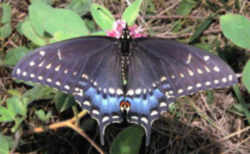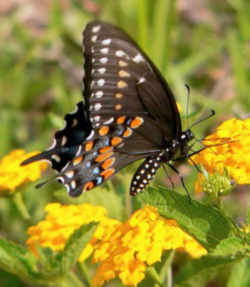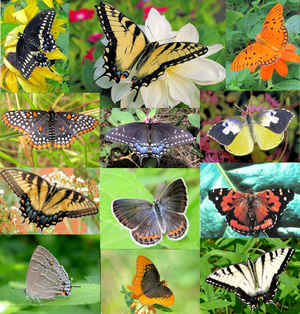
Oklahoma Symbols
Oklahoma State Butterfly
Black Swallowtail Butterfly

(Papilio polyxenes)
Adopted on November 1, 1996.
Oklahoma designated the black swallowtail, (Papilio polyxenesis,) as the official Oklahoma state butterfly on November 1, 1996. Oklahoma is a home to a wide varitey of colorful butterflies. The black swallowtail is a migratory species indigenous to the state from May to October.
Oklahoma is fortunate in providing a home to a wide array of colorful butterflies. The black swallowtail, (Papilio polyxenes,) is a migratory species indigenous to our state from May to October. The black swallowtail plays a vital role in the cross-pollination of plant life in Oklahoma, which is a necessary link in the chain which supports our ecology. In addition, the presence of the black swallowtail in Oklahoma not only adds color and beauty to our state but provides enjoyment for our citizens and an opportunity to study and understand the contributions this insect makes to our environment. quote from House Bill No. 2082
Oklahoma State Butterfly: Black Swallowtail

Oklahoma's official state butterfly is the black swallowtail. There are nine species of swallowtails in the state. Five of these (pipevine, zebra, black, giant and Eastern tiger) are found at the Tallgrass Prairie Preserve.
The black swallowtail is a black butterfly with yellow markings near the margins of the forewings and hindwings and more limited blue and red markings on the hindwings. Its wing span can reach 4 ? inches. Full grown parselyworms or caterpillars can reach 2 inches in length and are smooth and green, marked with black bands and yellow spots.
The black swallowtail mimics the bad tasting pipevine swallowtail, Battus philenor (Linnaeus), which is all metallic black-blue on the upper surface of the wings, lacking the yellow and blue markings. Caterpillars feed on pipevines, Dutchman's-pipe and Virginia snakeroot.
Females lay their eggs on plants in the parsley family such as Queen Anne's lace, dill and fennel. They fly from spring to fall and are very common in Oklahoma. Males patrol on hilltops for females (called hilltopping), so a good place to find them at the preserve is on the short trail at the top of the hill. Adult nectar sources include many plants common to the Tallgrass Prairie Preserve such as thistle and milkweed.
Characteristics of Oklahoma Black Swallowtail
Black Swallowtail (Papilio polyxenes Fabricius)
Wing span: 3 1/4 - 4 1/4 inches (8 - 11 cm).
Identification: Upper surface of wings mostly black; on inner edge of hindwing is a black spot centered in larger orange spot. Male has yellow band near edge of wings; female has row of yellow spots. Female hindwing with iridescent blue band. In the Southwest, yellow forms predominate in the subspecies P. coloro.
Life history: Males perch and patrol for receptive females. Female lays eggs singly on leaves and flowers of the host, which are then eaten by hatching larvae. Hibernates as a chrysalis.
Flight: One-2 flights from April-October in northern regions of range; 3 flights in southern regions.
Caterpillar hosts: Leaves of plants in the parsley family (Apiaceae) including Queen Anne's Lace, carrot, celery and dill. Sometimes plants in the citrus family (Rutaceae) are preferred.
Adult food: Nectar from flowers including red clover, milkweed, and thistles.
Habitat: A variety of open areas including fields, suburbs, marshes, deserts, and roadsides.
Range: Most of the eastern US, north into Quebec, west into s. Saskatchewan, Colorado and se. California; south to n. South America. Subspecies coloro in desert Southwest.
Oklahoma House Bill No 2082
House Bill No. 2082
An Act relating to state emblems;
designating the black swallowtail as the state butterfly of the State of Oklahoma;providing for codification; providing for noncodification; and providing
an effective date.
Be it enacted by the People of the State of Oklahoma:
SECTION 1. Oklahoma is fortunate in providing a home to a wide array of colorful butterflies. The black swallowtail, Papilio polyxenes, is a migratory
species indigenous to our state from May to October. The black swallowtail plays a vital role in the cross-pollination of plant life in Oklahoma, which
is a necessary link in the chain which supports our ecology. In addition, the presence of the black swallowtail in Oklahoma not only adds color and
beauty to our state but provides enjoyment for our citizens and an opportunity to study and understand the contributions this insect makes to our environment.
SECTION 2. NEW LAW A new section of law to be codified in the Oklahoma Statutes as Section 98.5 of Title 25, unless there is created a duplication
in numbering, reads as follows:
The black swallowtail, Papilio polyxenes, is hereby designated and adopted as the state butterfly of the State of Oklahoma.
SECTION 3. The provisions of Section 1 of this act shall not be codified in the Oklahoma Statutes.
SECTION 4. This act shall become effective November 1, 1996.
Approved April 1, 1996.
Oklahoma Law
The law designating the black swallowtail as the official Oklahoma state butterfly is found in the Oklahoma Statutes, Title 25, Section 25-98.5.
Title 25. Definitions and General Provisions.
Chapter 3 - State Emblems and Honorary Positions.
SECTION 25.98.
§25-98.5. State butterfly.
The black swallowtail, Papilio polyxenes, is hereby designated and adopted as the state butterfly of the State of Oklahoma.
Added by Laws 1996, c. 11, § 2, eff. Nov. 1, 1996.
Taxonomic Hierarchy: Black Swallowtail Butterfly
Kingdom: Animalia (Animals)
Phylum: Arthropoda (Arthropods)
Subphylum: Hexapoda (Hexapods)
Class: Insecta (Insects)
Order: Lepidoptera (Butterflies and Moths)
Superfamily: Papilionoidea (Butterflies and Skippers)
Family: Papilionidae (Swallowtails, Parnassians)
Subfamily; Papilioninae
Tribe: Papilionini (Fluted Swallowtails)
Genus: Papilio
Species: polyxenes (Black Swallowtail - Hodges#4159)
Butterflies, and Bugs







